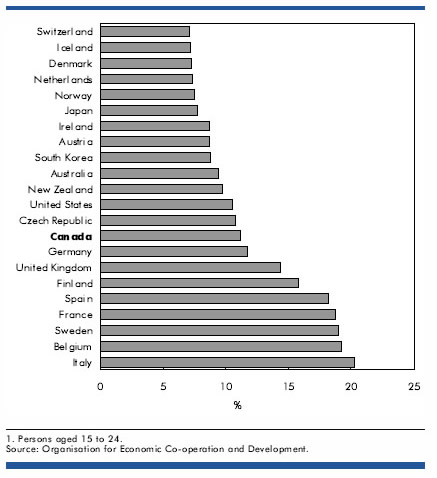Archived Content
Information identified as archived is provided for reference, research or recordkeeping purposes. It is not subject to the Government of Canada Web Standards and has not been altered or updated since it was archived. Please "contact us" to request a format other than those available.
Quick fact
Youth unemployment in Canada and selected OECD countries
The youth unemployment rate in Canada was 11% in 2007, higher than in countries such as Switzerland or the Netherlands (7%), but lower than in countries such as the UK, Finland, France, Sweden and Italy where the jobless rate of persons aged 15 to 24 varied between 14% and 20%, according to OECD labour force estimates.1
From an annual average of 13% between 2000 and 2005, youth unemployment in Canada fell to 11% in 2006 and 2007. At the same time, their employment rate rose by 3 percentage points from 2000; by 2007, 59.5% of Canadian youths had a job.
Youth unemployment in Canada and selected OECD countries, 2007

Among OECD countries with high youth unemployment such as France (19%) and Italy (20%), the participation rate tends to be low—37% in France and 31% in Italy, compared with 67% in Canada. On the other hand, Switzerland, where youth unemployment is 7%, has the same youth labour participation rate as Canada. The Netherlands, where youth unemployment is also 7%, has a youth participation rate of 71%.
Note
1. OECD labour force data come from national statistical offices of member countries. For Canada, the data source is Statistics Canada, Labour Force Survey.
Related to this topic:
Jobs for Youth: Canada , OECD report, June 2008.
Youth and the labour market, Perspectives on Labour and Income, Statistics Canada, November 2005.
You need to use the free Adobe Reader to view PDF documents. To view (open) these files, simply click on the link. To download (save) them, right-click on the link. Note that if you are using Internet Explorer or AOL, PDF documents sometimes do not open properly. See Troubleshooting PDFs. PDF documents may not be accessible by some devices. For more information, visit the Adobe website or contact us for assistance.
- Date modified: